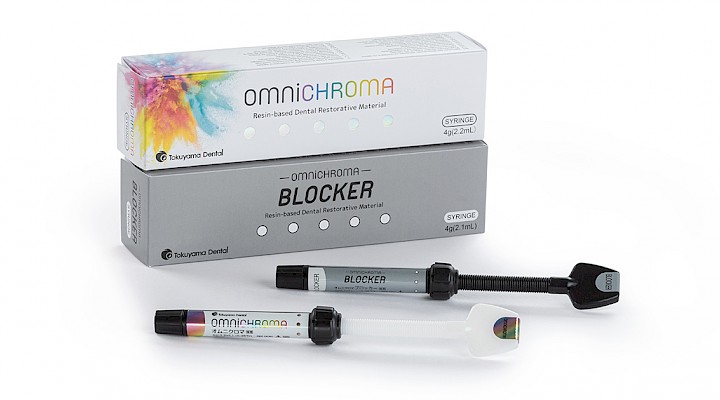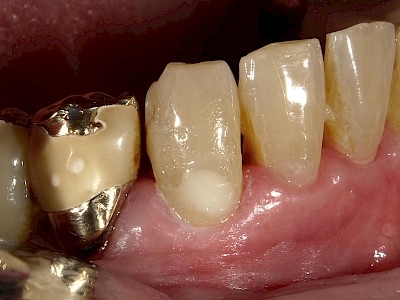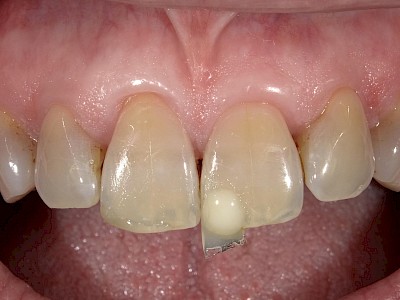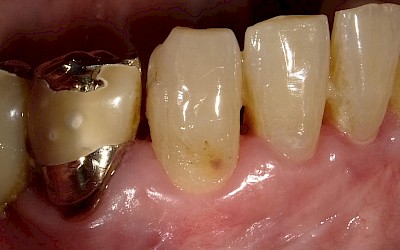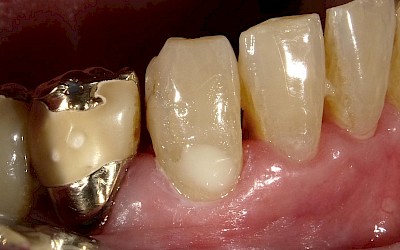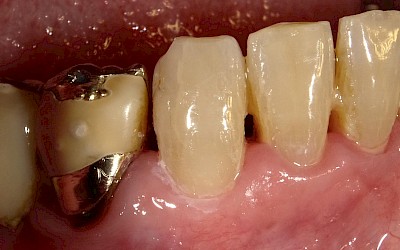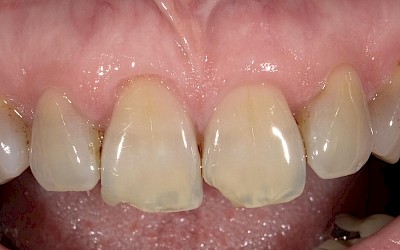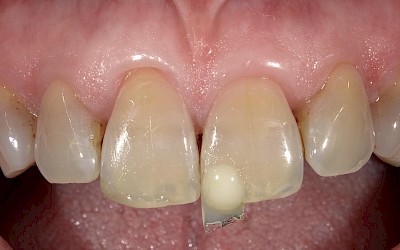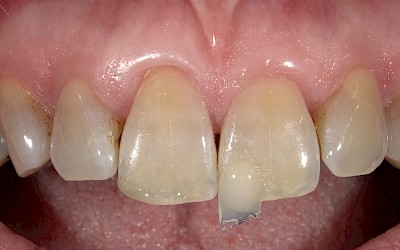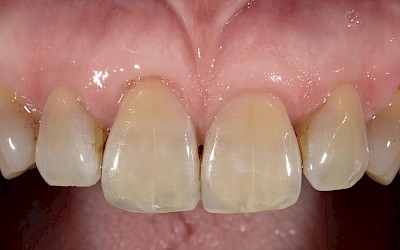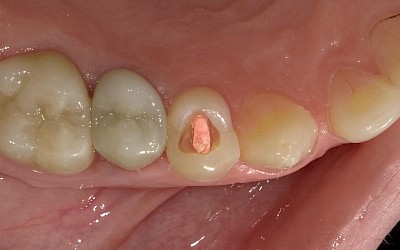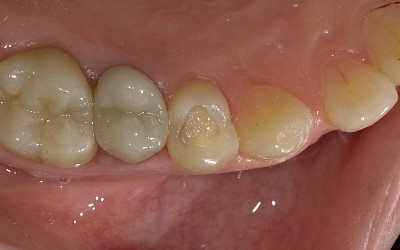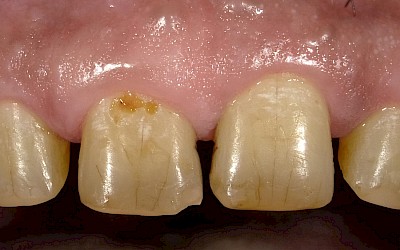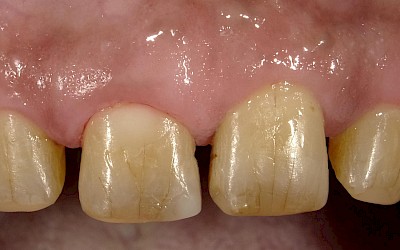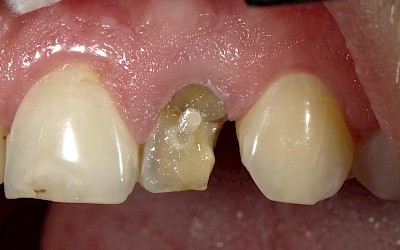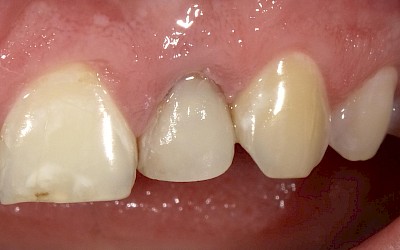First clinical experiences with the new universal composite OMNICHROMA
At IDS 2019, the Japanese manufacturer TOKUYAMA DENTAL launched an "idiochromatic" resin filling material for direct adhesive restorations on the market.
With the innovative restoration materials OMNICHROMA and OMNICHROMA BLOCKER - i.e. with exactly only two (!) composite materials - it is possible for the practitioner to achieve a harmonious shade of all anterior and posterior fillings, direct composite veneers, diastema reductions as well as repairs of plastic and ceramic defects - without prior complicated shade determination or subsequent noticeable shade discrepancies.
Sounds unbelievable? But it's true, as far as the author's own clinical experience has shown. See for yourself!
No more colour determination necessary!
With the two specially designed composites OMNICHROMA (for all normally translucent restorations) and OMNICHROMA BLOCKER (as substructuring supplementary material, if a significantly lower transparency of the restoration is required), TOKUYAMA DENTAL has established a completely new group of restoration materials for direct adhesive restoration services within the framework of esthetic tooth preservation measures:
"Idiochromatic" filling materials.
These are [according to the definition proposed by the author here] "restoration materials which achieve their suitable colour and light-optical effect (after light-curing) "in their own way" or "out of themselves" (equals "idio-") in the defect area to be reconstructed." "Restoration materials which achieve their suitable colour and light-optical effect (after light-curing) in their own way" or "out of themselves" (equals "idio-") in the defect area to be reconstructed. These special, actually completely new dental materials for the aesthetic treatment of defects do not require any previous colour selection within the framework of their direct intraoral use. The color matching ability of these materials, called "Color Adjustment Potential" in the Anglo-American context, makes considerations regarding the tooth color best suited for the defect restoration completely obsolete. Materials in this group of materials also render obsolete concerns regarding the reliable colour fidelity of the restoration material before and after light curing.
In summary, it can therefore be stated that the clinically extremely relevant questions regarding "shade compatibility", "shade fidelity" and "shade interactions" no longer arise in the intraorally performed direct adhesive tooth-coloured defect restoration using the OMNICHROMA composites presented here.
The innovatively developed OMNICHROMA composites are based on TOKUYAMA DENTAL's proven and continuously optimized resin filling materials. According to the manufacturer, all important material properties are of the same high quality as those of ESTELITE composites. In the opinion of the author reporting here, this cannot be contradicted for the period of the previous use of OMNICHROMA and OMNICHROMA BLOCKER: Handling, processing, user-friendly light-curing, finishing (contouring/finishing), polishing and other important, clinically obvious characteristics of these new composites do not differ from the comparable ESTELITE products of the Japanese manufacturer and developer of dental consumables.
"Smart Chromatic Technology" makes it possible
These practical-clinically absolutely amazing aesthetic properties of the two "idiochromatic" OMNICHROMA composites are based on further material characteristics exclusively created by TOKUYAMA DENTAL. These can be described very simply in this way: The inorganic filler particles have an almost uniformly sized spherical shape of approx. 260 nm diameter each. At a filler content of 79 percent by weight, these spherical bodies are in such close contact with each other that, with this special particle size, shape and distribution, light entering the composite material (apparently only white, but nevertheless "containing spectral colors") is brought back to the observer within the framework of a physical-light-optical effect - the so-called "structural color phenomenon" - exclusively in the red-yellow wavelength range. This selected color range of the visible light is caused by the "additive color mixing" occurring with this effect and corresponds exactly to the color or light wave range of natural teeth. As the "structural shade phenomenon" does not cause any "subtractive shade mixing" of the precipitating light, the restoration material can independently adopt the predominant tooth shade of the surrounding natural or artificial tooth substance in a kind of "super chameleon effect".
Case studies
In this section, the use of OMNICHROMA and OMNICHROMA BLOCKER in the author's practice will be demonstrated by means of clinical illustrations.
The use of these two composites represents a significant change compared to all conventional procedures for direct esthetic adhesive restorations. This is because there is no prior determination of the tooth shade that is at least arbitrary or better scaled for safety reasons; in addition, both OMNICHROMA and OMNICHROMA BLOCKER are greyish-yellow and absolutely opaque prior to light-curing (Fig. 2 and Fig. 5).
These fact pockets can therefore have an influence on the user's feelings when using OMNICHROMA for the first time on a "real patient", as they may be before the first ride on a roller coaster, for example [or, to be honest, were the case with the author writing here at the time]: You don't know exactly what to expect right away. And you already feel a bit queasy. - But after successfully completing your first trip, you're totally positively surprised, fully enthusiastic about the whole thing, would like to start again immediately... and experience this thrill again and again... Restorative dentistry can therefore be pleasantly spectacular.
OMNICHROMA
Figures 1 to 7 show the use of OMNICHROMA alone. The sequence of the purely technical filling procedure (for direct adhesive composite restorations) does not change at all, as already explained above.
As developer and manufacturer of the product, TOKUYAMA DENTAL recommends a light-curing time of 20 seconds for a maximum layer thickness of 2 millimeters per composite increment if the halogen photopolymerization lamp has a light output of at least 600 mW/cm². This specification should be observed at all costs, as the opacity of OMNICHROMA is very conspicuous.
What also catches the eye during clinical use is that OMNICHROMA can also become amazingly transparent after light-curing - depending on the structural requirements of the surrounding natural tooth structure. This becomes particularly obvious in the direct comparison of Figures 4, 5 and 6, which show the restoration of incisal enamel defects.
OMNICHROMA BLOCKER
Figures 8 to 11 show the exclusive use of the OMNICHROMA BLOCKER, which is clearly opaque after light curing. In Figures 8 and 9 the use is targeted and intentional. In Figures 10 and 11 erroneously! Since the less transparent composite from this "idiochromatic" restorative material group is expressly designated by the manufacturer as a composite material that reduces the translucency of a filling, this should also be taken into account. Therefore, never use OMNICHROMA BLOCKER for cover fillings. The domain of this composite is the underfilling or covering filling. According to the author's experience, OMNICHROMA BLOCKER is the material of choice when post-endodontic final fillings are to give an impression that is both aesthetically pleasing and biomimetically lightfast, without the need for complicated determination of the dentin or enamel shade.
OMNICHROMA + OMNICHROMA BLOCKER
Figures 12 and 13 illustrate the combined use of the OMNICHROMA and OMNICHROMA BLOCKER. The reader is allowed to critically consider this direct adhesive build-up filling, which could also be said to be a somewhat meaningful direct composite veneer. Before a judgement is made, however, it should be noted that this composite restoration - with adherence to all requirements of an adhesive-technologically lay artis direct filling - could only take about 15 minutes to complete due to time constraints.
With a preceding detailed shade determination, it would not have been possible to maintain this time span for a shade- and morphologically satisfactory restoration of the tooth crown.
Conclusion
The truly innovative OMNICHROMA and OMNICHROMA BLOCKER restorative materials open up a further opportunity to come a significant step closer to the fundamental wish of dental practitioners to be able to use "only one, but universally applicable filling composite".
It remains to be seen to what extent these "idiochromatic" materials for the direct adhesive restoration of hard tooth substance defects will be able to establish themselves as generally accepted resin restorative materials, just as the 'terminus technicus' chosen by the author for the light-optical shade matching properties will establish itself in general. Last but not least, it remains to be seen what independent research and science will have to say about this truly revolutionary and innovative material.
From the point of view of the author writing here - as a clinical user in the context of routine everyday dental restorations - this promising material category, to which OMNICHROMA and OMNICHROMA BLOCKER belong as pioneers, is without doubt very promising.
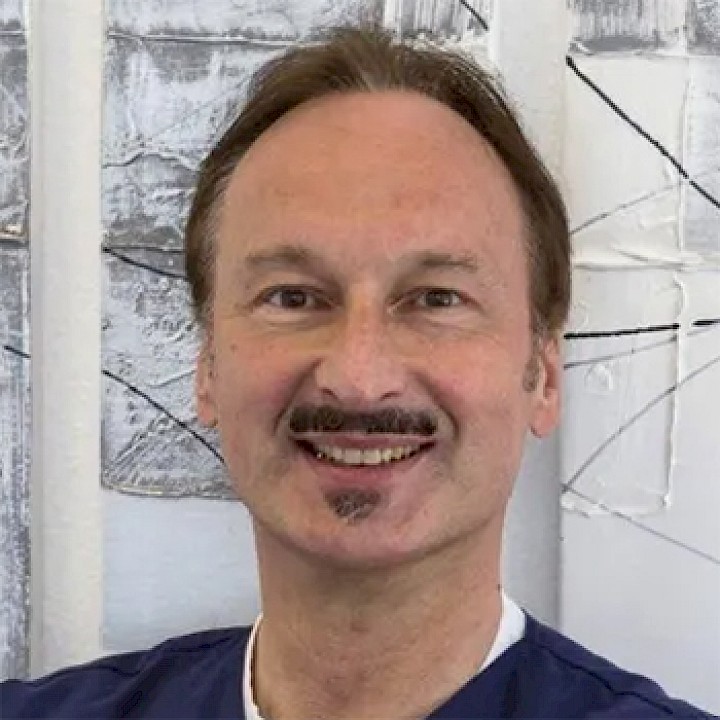
Author:
Dr Markus Th. Firla
Dental practitioner since 1994 in his own practice for dentistry, oral and maxillofacial surgery in Hasbergen / Dental specialist author and lecturer on dental topics / Further training lecturer for the Lower Saxony Chamber of Dentists
Hauptstr. 55
DE-49205 Hasbergen
Germany
Phone: +49 5405 69988
dr.firla@homeofdentalcare.de
https://www.homeofdentalcare.de
- Kraus L. A.: Etymological medical lexicon. Anton v. Haykul, printer and Michael Lechner, university bookseller. Vienna 1831.
- Pereira Sanchez N., Powers J. M. et al.: Instrumental Evaluation of Color Adjustment Potential of Resin Composites. The University of Texas, School of Dentistry. Abstract Control ID#: 2957194, 2018.
- Pereira Sanchez N., Powers J. M., Paravina R. D.: Visual Evaluation of Color Adjustment Potential of Resin Composites. The University of Texas, School of Dentistry. PP Presentation, 2018.
- Tokuyama Dental Corporation: Omnichroma - Technical Report. Tokyo, 2018.
